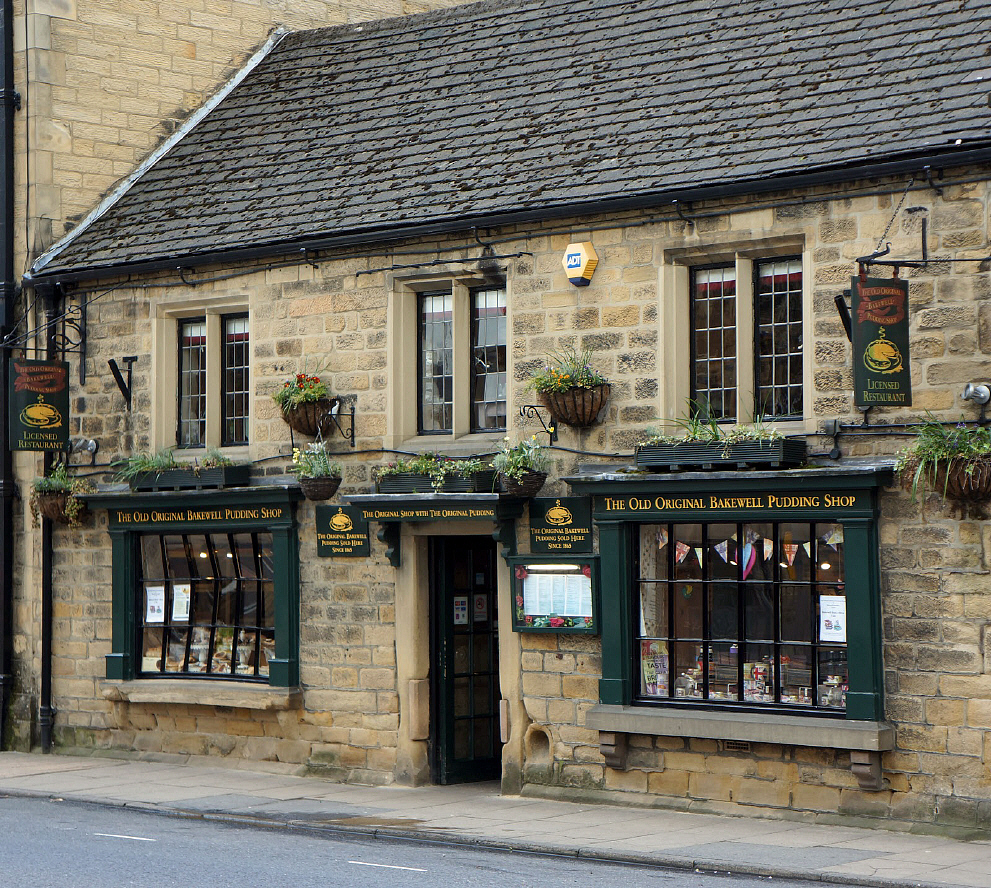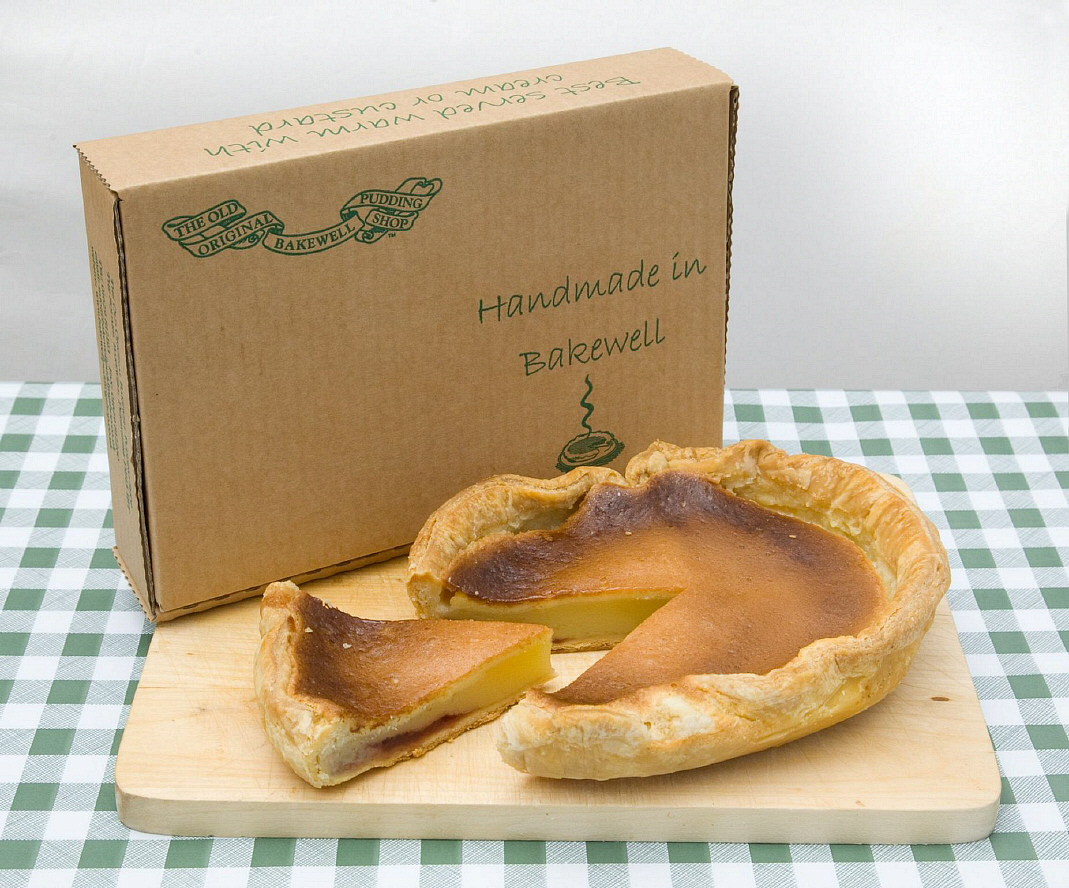

|
 A speciality of the Derbyshire town of Bakewell, generally taken to be the origin of the now better-known Bakewell Tart. Puff pastry base, coated with jam and a mixture of egg, ground almond, butter and sugar, baked. There are at least four bakeries in Bakewell producing the puddings with variable and unverified claims to be the original. A common legend is that the puddings were invented in the 1860s when a nobleman visiting the White Horse Inn (now The Rutland Arms) ordered strawberry tart and the cook, instead of stirring the egg mixture into the pastry, spread it on top of the jam. However, in line with the usual suspicion of anything in the food line claiming to have aristocratic origins, receipts for Bakewell Tart are known from at least the 1820s and it occurs in the 'The Housekeeper's Book of faraway Philadelphia, USA as early as 1839, suggesting that its fame had spread widely. Indeed the ('Derby Mercury' - Wednesday 24 February 1841, p3) talks of the of "the far-famed Bakewell Pudding" being served at a ball, not at the White Horse, but in the Castle Inn on Castle Street.  The Old Original Bakewell Pudding Shop One of the (at least) four Bakewell Pudding Bakeries in Bakewell Image: Unknown Bakewell Pudding seems to be an enriched local variant of the 18th Century 'Sweetmeat Puddings ', known from 'The Lady's Assistant' (1777) in 'The English Art of Cookery' (1788), in 'The London Art Of Cookery' (1811) and as recently as 1914 in 'Pot-Luck, British Home Cookery' and here, the earliest known version, from 1727...  Original Receipt from Eliza Smith's 'The Compleat Housewife' (London 1727, 1739) Original Receipt from Eliza Smith's 'The Compleat Housewife' (London 1727, 1739)To make a sweet-meat Pudding. PUT a thin puff-paste at the bottom of your dish, then have of candied orange and lemon-peel, and citron, of each an ounce, slice them thin, and put them in the bottom on your paste; then beat eight yolks of eggs, and two whites, near half a pound of sugar, and half a pound of butter melted; mix and beat all well together, and when the oven is ready, pour it on your sweet-meats in the dish. An hour or less will bake it The first printed receipt for Bakewell Pudding, by that name, we can find is in a vegetarian cookery book from 1821. This receipt adds mashed potato, though it is likely that this meant the Sweet Potato, as seems to be the case with other earlier sweet tart receipts.  Original Receipt in the 'Vegetable cookery ' by Martha Brotherton (See: Vegetable 1821); Original Receipt in the 'Vegetable cookery ' by Martha Brotherton (See: Vegetable 1821);1280. Bakewell Pudding. Take the yolks of four eggs and the whites of two well beaten, a quarter of a pound of butter melted, two ounces of almonds chopped or beaten fine, loaf-sugar to the taste, two good mealy potatoes boiled, well dried, and mashed fine. Cover a shallow dish with good puff paste, spread a thin layer of fruit jam, or marmalade, then pour in the mixture and bake it. Bloomers Pudding Shop in Bakewell bloomersofbakewell.co.uk  Image: www.bakewellpuddingshop.co.uk The first receipt we know of in Derbyshire itself is in a hand-written manuscript by Clara Palmer-Morewood of Alfreton Hall, dated 1837, acquired by Derbyshire Record Office .  Original Receipt from Clara Palmer-Morewood of Alfreton Hall, 1837 Original Receipt from Clara Palmer-Morewood of Alfreton Hall, 1837Bakewell Pudding Lay a puff pastry over a tin open-tart mould, put into it two dozen raisins stoned & chopped fine (stoned cherries would be better) almonds cut thin, candied orange peel or any kind of preserves, beat well the yolks of four eggs and the white of 1 and a 1/4 lb of clarified butter and 2 ounces powdered sugar, beat all together and fill up the mould with the mixture (lemon would improve it) bake it in a slow oven. To be eaten cold and sprinkled with powdered sugar 1837  The infulential Eliza Acton, in 1845, says it is "famous not only in Derbyshire, but in several of our northern counties, where it is usually served on all holiday occasions"...  Original Receipt from 'Modern Cookery for Private Families' by Eliza Acton (Acton 1845); Original Receipt from 'Modern Cookery for Private Families' by Eliza Acton (Acton 1845);BAKEWELL PUDDING. This pudding is famous not only in Derbyshire, but in several of our northern counties, where it is usually served on all holiday occasions. Line a shallow tart-dish with quite an inch-deep layer of several kinds of good preserve mixed together, and intermingle with them from two to three ounces of candied citron or orange-rind. Beat well the yolks of ten eggs, and add to them gradually half a pound of sifted sugar; when they are well mixed, pour in by degrees half a pound of good clarified butter, and a little ratifia or any other flavour that may be preferred; fill the dish two-thirds full with this mixture, and bake the pudding for nearly an hour in a moderate oven. Half the quantity will be sufficient for a small dish. Mixed preserves, 1 1/2, to 2 Ibs; yolks of eggs, 10; sugar, 1/2 Ib: butter, 1/2 Ib; ratifia, lemon-brandy, or other flavouring, to the taste. baked, moderate oven, 1/2 to 1 hour. Obs.-This is a rich and expensive, but not very refined pudding A variation of it, known in the south as an Alderman's Pudding, is we think, superior to it. It is made without the candied peel, and with a layer of apricot-jam only, six ounces of butter, six of sugar the yolks of six, and the whites of two eggs. Another Pudding Shop in Bakewell Most of the earlier versions added shredded peel, which is omitted in the modern commercial Bakewell Pudding. The receipt used now is first found in 1859, though it also offers a 'less rich' variant, again using potato...  Original Receipt from 'The English Cookery Book' edited by JH Walsh Walsh 1859; Original Receipt from 'The English Cookery Book' edited by JH Walsh Walsh 1859;Bakewell Pudding. 911. Cover a dish with thin paste. Put a layer of jam of any kind, half an inch thick. Take the yolks of five eggs, and the white of one, rather less than one pound of sugar, and four ounces of butter melted, and a few well-pounded almonds. Beat all together until it is well mixed. Pour it into the dish, and bake it in a moderate oven for an hour. They may be baked in pattypans to eat cold. Another, less rich.- The yolks of four eggs, whites of two well beaten, a quarter of a pound of melted butter, two ounces of almonds, sugar to taste, two potatoes boiled, dried, and mashed fine. Line a shallow dish with puff paste, put a layer of jam (strawberry is the best), and pour the batter upon it. Bake it well. For more Bakewell Pudding history, see Ivan Day's splendid Food Jottings. See also: Bakewell Tart Bakewells  |
|
MORE FROM Foods of England... Cookbooks ● Diary ● Index ● Magic Menu ● Random ● Really English? ● Timeline ● Donate ● English Service ● Food Map of England ● Lost Foods ● Accompaniments ● Biscuits ● Breads ● Cakes and Scones ● Cheeses ● Classic Meals ● Curry Dishes ● Dairy ● Drinks ● Egg Dishes ● Fish ● Fruit ● Fruits & Vegetables ● Game & Offal ● Meat & Meat Dishes ● Pastries and Pies ● Pot Meals ● Poultry ● Preserves & Jams ● Puddings & Sweets ● Sauces and Spicery ● Sausages ● Scones ● Soups ● Sweets and Toffee ● About ... ● Bookshop ● Email: editor@foodsofengland.co.uk COPYRIGHT and ALL RIGHTS RESERVED: © Glyn Hughes 2022 BUILT WITH WHIMBERRY |